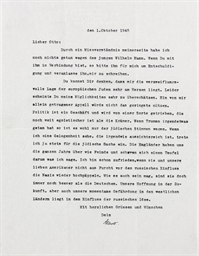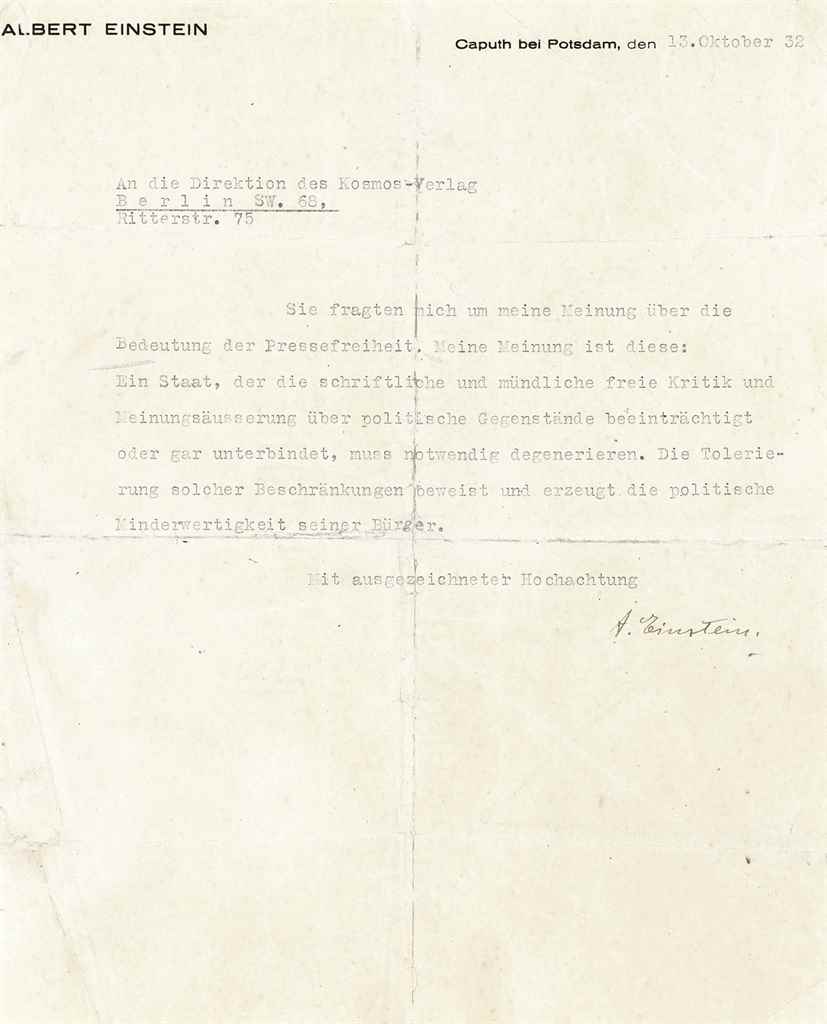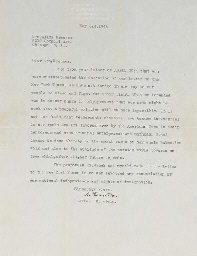EINSTEIN, Albert. Typed letter signed ("A. Einstein.") with 10-word autograph addition, to Moses Gordon, Princeton, N.J., 13 January 1944. 1½ pages, 4to, on Einstein's personal stationery, separate envelope. [With:] Two carbon copies of typed letters of Gordon to Einstein, 1 December 1943 and 25 March 1944. 4 pages, 4to. EXPLAINING THE THEORY OF RELATIVITY A strikingly thoughtful, detailed letter in which Einstein considers questions regarding the theory of relativity posed by blind scientist Moses Gordon, prompted by his recent reading of The Evolution of Physics . In his letters to Einstein (carbons present), Gordon asks theoretical questions about "the new mechanical concept...on which the special Theory of Relativity is based." Einstein responds specifically to Gordon's comments: "Your argumentation concerning the molecule of copper and the gross mass of copper is not right. It is not possible to give to the molecule of copper the velocity of light, for this would require infinite energy." Einstein addresses the issue of mass, "I find it not very good to say that the mass of a body in movement is increased by the speed ... [the] rest mass is, f.i. for a molecule of copper, always the same, independent from the speed of the molecule." Einstein presents a detailed example utilizing the theory of relativity: "If you have, however, a box with a number of molecules therein then the rest mass of this whole system is dependent from the sum of the kinetic energies of these particles. This is so according to the results of the special theory of relativity." He explains: "1) According to the special theory of relativity the inertial mass of the system increases with the inner kinetic energy of the system. The increase is too small to be directly observed. But there is no question that this increase of inertial mass is real. It follows from observation concerning deviations of atomistic particles (electrons and ions) by electric and magnetic fields." Continuing, "2)The change of the gravitational mass" (here Einstein makes a ten-word autograph insertion) "of a body due to change of his inner energie [ sic ]," "are also too small to be directly verified. But we know that in the case of radio-active decompositions the sum of the atomic weights of the resulting atoms together is smaller than the mass of the decomposed original atom. The difference being determined by the kinetic and light energy produced by the radio-active process." Einstein concludes his thoughts with a commentary on the impact of movement upon gravitational fields and an interesting insight into the limitations of physics: "It is mostly the case in our science that the confirmations of the consequences of a physical theory have to be mostly indirect ones for reason of the limitations of experimental accuracy." The impact of Einstein's Theory of Relativity cannot be overstated. It challenged the very foundations of physics, and the reaction of the world was profound; "the intuitive realization that the new light cast on the physical world struck at the very vitals of what they had always believed. Few could understand the implications, let alone the complex intellectual structure from which these implications sprang" (Clark, p. 309). Together three items . (3)
EINSTEIN, Albert. Typed letter signed ("A. Einstein.") with 10-word autograph addition, to Moses Gordon, Princeton, N.J., 13 January 1944. 1½ pages, 4to, on Einstein's personal stationery, separate envelope. [With:] Two carbon copies of typed letters of Gordon to Einstein, 1 December 1943 and 25 March 1944. 4 pages, 4to. EXPLAINING THE THEORY OF RELATIVITY A strikingly thoughtful, detailed letter in which Einstein considers questions regarding the theory of relativity posed by blind scientist Moses Gordon, prompted by his recent reading of The Evolution of Physics . In his letters to Einstein (carbons present), Gordon asks theoretical questions about "the new mechanical concept...on which the special Theory of Relativity is based." Einstein responds specifically to Gordon's comments: "Your argumentation concerning the molecule of copper and the gross mass of copper is not right. It is not possible to give to the molecule of copper the velocity of light, for this would require infinite energy." Einstein addresses the issue of mass, "I find it not very good to say that the mass of a body in movement is increased by the speed ... [the] rest mass is, f.i. for a molecule of copper, always the same, independent from the speed of the molecule." Einstein presents a detailed example utilizing the theory of relativity: "If you have, however, a box with a number of molecules therein then the rest mass of this whole system is dependent from the sum of the kinetic energies of these particles. This is so according to the results of the special theory of relativity." He explains: "1) According to the special theory of relativity the inertial mass of the system increases with the inner kinetic energy of the system. The increase is too small to be directly observed. But there is no question that this increase of inertial mass is real. It follows from observation concerning deviations of atomistic particles (electrons and ions) by electric and magnetic fields." Continuing, "2)The change of the gravitational mass" (here Einstein makes a ten-word autograph insertion) "of a body due to change of his inner energie [ sic ]," "are also too small to be directly verified. But we know that in the case of radio-active decompositions the sum of the atomic weights of the resulting atoms together is smaller than the mass of the decomposed original atom. The difference being determined by the kinetic and light energy produced by the radio-active process." Einstein concludes his thoughts with a commentary on the impact of movement upon gravitational fields and an interesting insight into the limitations of physics: "It is mostly the case in our science that the confirmations of the consequences of a physical theory have to be mostly indirect ones for reason of the limitations of experimental accuracy." The impact of Einstein's Theory of Relativity cannot be overstated. It challenged the very foundations of physics, and the reaction of the world was profound; "the intuitive realization that the new light cast on the physical world struck at the very vitals of what they had always believed. Few could understand the implications, let alone the complex intellectual structure from which these implications sprang" (Clark, p. 309). Together three items . (3)















Try LotSearch and its premium features for 7 days - without any costs!
Be notified automatically about new items in upcoming auctions.
Create an alert